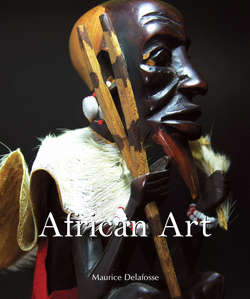Читать книгу African Art - Maurice Delafosse - Страница 10
На сайте Литреса книга снята с продажи.
Origins and Prehistory
The Negroes of Africa at the Time of Herodotus
ОглавлениеI have said above that it would perhaps be proper to attribute the local invention of working in iron to the Negroes of the second wave of immigration. It does not necessarily follow that they already knew this metal when they reached Africa or that they had not borrowed the secret of its manufacture from a foreign influence. In this regard, a passage from the History of Herodotus is very instructive. In Book II (§§ XXIX and XXX), the Greek author has given us approximately the northern limits attained at his time by the Negroes in the valley of the Nile, whom he calls “Ethiopians”. These limits are sensibly identical with those attained by them in our day. The Negroes were already found, he tells us, “above Elephantine”, upstream from the first cataract, some sedentary, others nomadic, living side by side with the Egyptians; but their true homeland began a little farther to the north of the present city of Khartoum, at Meroe, which, according to Herodotus, was their capital, and to the south of which lived the “Automoles”, Egyptians in the service of the king of the “Ethiopians”, who had established themselves in the adopted country, marrying Negro women and causing the Negroes of the region to benefit by Egyptian civilisation.
Further on (Book VII, § LXIX), passing in review the cosmopolitan contingents who made up the army of Xerxes, Herodotus tells us that the “Ethiopians” – a word which must always be understood to mean the African Negroes – were “clothed in leopard and lion skins, had bows made of the stems of palm-leaves at least four cubits in length, and long arrows of reed at the extremity of which was, instead of iron, a pointed stone which they also used for carving their seals. Besides this, they carried javelins armed with the horns of antelopes, pointed and worked like an iron lance-head and clubs full of knots. When they went into battle, they rubbed half of their body with chalk and the other half with vermilion”.
Who would not recognise in this portrait of Negro warriors many of the present tribes of the Gulf of Guinea, of the bend of the Niger and of equatorial or southern Africa? Apart from the arrow-heads and the javelin points which are now of iron instead of stone or horn, and by replacing the terms “chalk” and “vermilion” of the French translator[3] with “white earth” and “red earth”, it is striking to ascertain how little the equipment of the Negroes of the army or Xerxes, four and a half centuries BCE, differed from that which we can see, twenty-four centuries later, on many of their descendants. And we make no mistake about it: the “Ethiopians” in question were indeed the Negroes and not the ancestors of the present Abyssinians, to whom we commonly give the name Ethiopians. Herodotus himself specifies this detail a little further on (same Book, § LXX) by designating the Abyssinians as “Oriental Ethiopians” and in observing that they differed from the other “Ethiopians” in that they had straight hair, while the Negroes or western Ethiopians, whom he calls simply “Ethiopians” or “Ethiopians of Libya”, had hair “more frizzled than all other men”. He adds that these two peoples spoke different languages.
According to these diverse testimonies of Herodotus, joined to those of Hanno and of Sataspe, it can be inferred that, since the 5th century BCE, the Negroes occupied in the same territories of Africa where we meet them today, that they had almost achieved their ethnic formation, although their absorption of the Negrillos was not quite as complete as it has since become, and finally, that the customs and the material civilisation of the most advanced among them were essentially that which can be observed in our day among the Negroes who have remained the most primitive.
This will be the conclusion of the first chapter, which, as can be seen, is more filled with conjectures[4] than with facts. As the title indicates, we are dealing with prehistory, and prehistory remains inevitably within the domain of hypothesis, whatever be the human society to which it pertains. Only, in what concerns the Negroes of Africa, prehistory has lasted much, much longer than history and history does not begin until an epoch very near to our own time.
Statue (Mbole).
Wood, height: 58.5 cm.
Private collection.
Generally, Mbole statues portray hanged people. Held on wooden sticks, these statues are lined outside initiation camps as social regulators. Here, the support poles are an important part of the sculpture while the curve of her arms and legs provides a fantastic energy.
Ancestor statue (Hemba).
Wood, height: 64 cm.
Private collection.
Hemba artists provide a mysterious elegance and expression to their work, as seen in this serene statue. The calm power it exhibits clearly shows the respect which the Hemba people show their ancestors.
3
The translation cited is that of Larcher, revised by Emile Pessonneaux (Paris, 1883, pp. 508, 509).
4
Translator’s italics.
